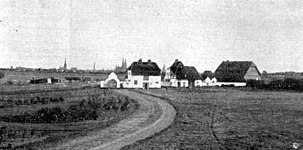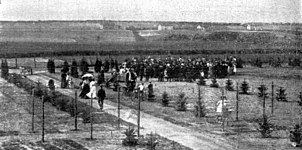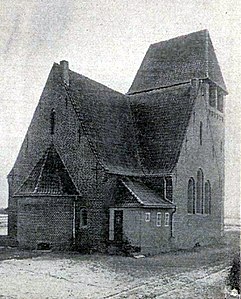August Langenbuch
August Nikolaus Carl Langenbuch (born October 11, 1870 in Klein Flottbek , † October 10, 1924 in Lübeck ) was a German landscape architect and head of the Lübeck cemetery administration . He had gone through a career as a horticultural engineer.
Life
origin
Alfred came from a family that took care of gardening . His father, Metaphius Theodor August Langenbuch (born September 4, 1842 in Eutin, † May 2, 1907 in Lübeck), was a German garden architect and city gardener. He laid out the facilities on the canal and the Lübeck city park as the main plant.
career
For his three-year apprenticeship as a gardener , Langenbuch first worked for a year on the trial field of the horticultural association and then for two years at the commercial gardening company Steltzner & Schmalz , where he subsequently worked as an assistant for another year . From 1890, like his father from 1864, he attended the gardening school in Potsdam under Ferdinand Jühlke .
Langenbuch then worked for six months at the Peter Smith & Co. tree nursery in Bergedorf . He was an active soldier until autumn 1894 and completed his two years of military service with the infantry of the Prussian Army in the fusilier battalion of the 2nd Hanseatic Infantry Regiment No. 76 in Lübeck.
In the years 1895 and 1896 Langenbuch was head gardener in the Botanical Garden in Stuttgart .
In the previous year, Langenbuch moved to Lübeck's municipal park administration and was appointed cemetery inspector for the Allgemeine Gottesackers in Israelsdorfer Allee in 1897. From 1898, on November 15, 1897, he was elected by the cemetery authorities to be their cemetery overseer, and he was responsible for the four municipal cemeteries, which were, in addition to the one already mentioned, the St. Lorenz and St. Jürgen cemeteries and the later St. Gertrud -Cemetery , administered.
- Vorwerker Friedhof 1906
Langenbuch's administrative spectrum expanded in 1906 to include the Vorwerker cemetery . Its plant was assigned to him, based on the design of the city gardener Erwin Barths . Here, too, he distinguished himself as the senior official with care and caution.
- Opening on May 13, 1907
With the first burial on May 13, 1907, the largest cemetery in the city was opened. The members of the cemetery authorities and the board members of the St. Lorenz and St. Matthäi congregations were invited to the funeral of the elderly fellow citizen from St. Lorenz .
- Morgue
From the in form like an old Vicelinkirche acting morgue was transferred to the coffin to the right of the columbarium already carefully with fir trees and conifers enclosed part of the cemetery. The work of the pallbearers to facilitate the coffin was lifted for this first time on a stretcher trolley. Pastor Johannes Evers was a member of the cemetery authority and has now carried out the inauguration.
The diverse systems and the appropriate division into individual fields and burial sites were Langenbuch's work.
- chapel
The construction of a chapel , decided by the council and citizens' resolution of April 17, 1907 , whose construction was not yet approved by the citizens on July 18, 1904, was built in 1908 and 1909. Inside, it forms a single-nave , cross-shaped room with a semicircular end of the choir . The interior is arched in all parts . The height above the crossing is 9 meters. In the tower there is an anteroom that takes up almost the entire width of the nave. Above it is an organ gallery that offers space for a male choir of up to 78 members. The chairs in the church interior offered space for 108 people.
The chapel was built in the style of homeland security architecture. Its carved pulpit is elevated on the steps at the end of the choir. Next to the choir is a small sacristy that can also be reached from the outside , as well as a pallbearer room. However, the two extensions were already perceived as dissonances to the harmony of the chapel when the chapel opened. Contrary to the expectation that all components that formed a whole would be uniformly designed in the external architectural development, those were externally characterized as not belonging components. In contrast to the chapel, the outer walls of which were made of bricks , the outer walls of the two extensions were plastered .
The plans and construction plans were processed by the building authority , while the construction management was in the hands of the architect Strobelberger. The executive bodies involved were:
Schulz $ Sohn (masonry), Blunk & Sohn (carpentry), Schubert (plumbing), Füllkell (roofer), Meins Moislingen (windows), Steffens (doors and chairs), Erdmann (carving), Berkenthien (lead glazing), Voht (painting ), Eggert (painting of windows and doors), Köri Berlin (central heating), HL Behn (delivery of the floor panels )
- crematorium
The new state crematorium has been built at the far end of the cemetery, close to the land moat that marks the border between Lübeck and Oldenburg . With its high and massive granite plinth , its steep roof and its pleasing lines, it blended into the landscape and the building artist, building inspector Carl Mühlenpfordt , created a monument with it. The interior design of the cremation church, however, did not succeed as well as the exterior.
A simple porch was reached through the portal via a wide flight of stairs framed by mighty square stringers . From there a staircase led up to the choir and from there through a second double door into the main hall or funeral hall, which is equipped with large, slender windows. At the back of the main hall, on a small elevation, to which steps lead up, stands the blessing pulpit under a round arch spanning over it . Right in front of her, between the pillars supporting a canopy, is the recess that accommodates the coffin. To the north of the funeral hall is the sacristy and to the south a narrow room for the relatives. Under it is the combustion chamber with the in firebricks executed incinerator. The ash is collected in a capsule in the furnace below . This could be buried in the urn cemetery part of the Vorwerk cemetery, which is surrounded on three sides by the cremation church.
On March 22, 1910, a test cremation that was satisfactory to all sides took place in the new state crematorium . Langenbuch explained in detail to the members of the citizens who visited the crematorium on May 12th its individual facilities and processes. The shell of Countess Louise von Baudissin, mother of the writer Count Wolf von Baudissin (Baron von Schlicht) was the first body to be cremated on May 17th and the crematorium was inaugurated. Since its later gutting , the crematorium has only been used for cremation .
All the buildings in the cemetery were designed and built with his assistance .
The layout of the Vorwerk cemetery, which is considered to be Langenbuch's main work, has repeatedly been recognized as "exemplary" by the authorities of cemetery art.
During the First World War , the newly created cemetery of honor also came under Langenbuch's area of responsibility .
In addition, a burial ground for dead German soldiers and a framed by fir trees burial ground for more than 80 in captivity was in the cemetery Vorwerker deceased Russians created. Lined up wooden crosses of the same size marked the soldiers' graves - typed graves - and impressed the viewer. On the grave of a Russian Asiatic Mohammedan denomination, under the cross, the symbol of the Christian faith, was a simple wooden plaque with the Asiatic inscription. Recumbent grave slabs were not very popular, although they give a very calm overall impression. They disappeared under snow and quickly planted moss. However, this cemetery was unknown to most cemetery visitors because it was remote. After the Second World War , however, this was to change due to the construction of more war cemeteries in the vicinity. For example, the Estonian war cemetery was built opposite the field in 1947 . This has changed.
The cemetery inspector died after long and severe suffering. On October 14th, his urn was buried in the middle of the flower and plant groves he had created.
family
Langenbuch was married to Emilie (* 1871, † 1961), née König. Out of marriage
- Theodor (1894–1974), only Theo between the wars
- he was married to Martha (1907–1971), born Eggebrecht
- Anny (1898-1992)
- she was married to Hans Schöning (1898–1963)
- Meta (1902-1906)
as children.
literature
- At the “Vorwerker Friedhof”. In: Vaterstädtische Blätter , year 1906, No. 40, edition of September 30, 1906, pp. 161–163.
- The inauguration of the Vorwerker cemetery. In: Vaterstädtische Blätter , year 1907, no. 21, edition of May 19, 1907, pp. 82–83.
- The chapel in the Vorwerker Friedhof. In: Vaterstädtische Blätter , year 1909, no. 7, edition of February 14, 1909, pp. 25-26.
- The Lübeck crematorium. In: Vaterstädtische Blätter , year 1910, No. 24, issue of June 12, 1910, pp. 93–95.
- Theodor Echtermeyer : Biographies in the commemorative publications of the gardening school at the Wildpark near Potsdam 1913. , Royal Gardening School Dahlem, Berlin 1913, pp. 223–224.
- Cemetery inspector August Langenbuch †. In: Vaterstädtische Blätter , year 1924/25, No. 3, edition of November 2, 1924, pp. 9-10.
Web links
Individual evidence
- ↑ City gardener Langenbuch †. In: Lübeckische Blätter , 49th volume, No. 19, edition of May 12, 1907, pp. 263–265.
- ↑ Steltzner & Schmalz Successor : Owner Gebrüder Hartwig.
- ^ Theodor Echtermeyer: Biographies in the Festschriften of the gardening school at the Wildpark near Potsdam 1913. , Königliche Gärtnerlehranstalt Dahlem, Berlin 1913, pp. 18-19.
- ^ Theodor Echtermeyer: Biographies in the Festschriften of the gardening school at the Wildpark near Potsdam 1913. , Königliche Gärtnerlehranstalt Dahlem, Berlin 1913, pp. 223–224.
- ↑ Peter Smith & Co. Owner: Julius Rüpell and Theodor Klink.
- ↑ Erwin Barth was the successor of Langenbuch's father in the office of city gardener.
- ↑ After Langenbuch's death, Senator William Bromme, as chairman of the cemetery authority, emphasized his care and caution in his particularly honorable obituary. All the Lübeck newspapers quoted this obituary in their reports.
- ↑ In the columbarium, above the door from the vestibule to the morgue, it still says "WHO REMAINS IN THE MEMORY OF HIS LOVED ONES IS NOT DEATH * HE IS NVR FAR * DEATH IS NVR WHO IS FORGOTTEN"
- ↑ March 22nd was a special date for symbolic acts in the German Empire, as the heroic emperor was born on March 22nd, 1797 .
- ↑ Weekly Chronicle. In: Vaterstädtische Blätter , year 1910, No. 13, edition of March 27, 1910, p. 52.
- ↑ Weekly Chronicle. In: Vaterstädtische Blätter , year 1910, No. 20, edition of May 15, 1910, p. 80.
- ↑ New forms in tomb art. In: Vaterstädtische Blätter , year 1930/31, No. 7, edition of January 3, 1931, pp. 26-27.
| personal data | |
|---|---|
| SURNAME | Langenbuch, August |
| ALTERNATIVE NAMES | Langenbuch, August Nikolaus Carl (full name) |
| BRIEF DESCRIPTION | German landscape architect |
| DATE OF BIRTH | October 11, 1870 |
| PLACE OF BIRTH | Klein Flottbek |
| DATE OF DEATH | October 10, 1924 |
| Place of death | Lübeck |
















